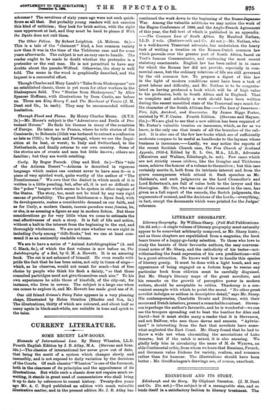Literary Geography. By William Sharp. (Pall Mall Publications. 10s. 6d.
net.)—A single volume of literary geography must naturally appear to be somewhat arbitrarily composed, as Mr. Sharp hints ; and as these chapters are republished from a magazine, the book bears traces of a happy-go-lucky selection. To those who love to study the haunts of their favourite authors, the easy conversa- tional notes of Mr. Sharp, and the catholicity of his tastes—not- withstanding the frank expression of his own predilections—will be a great attraction. He knows well how to handle this species of literary gossip. It must be done with a light touch, and any appearance of being engaged on a forlorn hope to rescue any particular book from oblivion must be carefully disguised. But Mr. Sharp's literary maps of the great novelists, and his remarks on the growth of perceptive power in modern writers, should be acceptable to critics. Thackeray is a con- venient example with which to point the moral. "No other great novelist indulges so seldom in descriptive detail," says Mr. Sharp. His contemporaries, Charlotte Bronto and Dickens, with their moors and Dutch interiors, present a remarkable contrast. Steven- son is perhaps the author's favourite, and he is wonderful—we can see the troopers spreading out to beat the heather for Alan and David—but it must strike many a reader that it is Stevenson, and not Balfour, who sees those dawns and sunsets. " Aylwin- land " is interesting from the fact that novelists have some- what neglected the East Coast. Mr. Sharp found that he had to throw a wide net when chronicling the associations of Lake Geneva; but if the catch is mixed, it is also amusing. We gladly help him in circulating the name of M. de Wyzewa, an able Continental critic, from whom we learn that Russians, French, and Germans value Dickens for variety, realism, and romance rather than for humour. The illustrations should have been better : Mr. Greiffenhagen's drawings are, of course, excellent.
EDINBURGH AND ITS STORY.






































































 Previous page
Previous page